Media | Articles
Celebrate 70 Years of AMC with 10 of Our Favorite Cars
AMC was founded on May 1, 1954, when Hudson Motor Car Company and Nash-Kelvinator Corporation merged to better compete and survive against the Big Three. The plan worked, to an extent: AMC outlived Studebaker, Packard, and Kaiser-Jeep, the latter of which survived the longest, making it to 1970 before it was acquired by AMC. In 1987 AMC itself was purchased by Chrysler, and today only Jeep survives.
Over the brand’s 33-year run, it built family haulers, sports cars, off-roaders, and innovative compacts with a fraction of the resources of the Big Three, and the models often punched above their weight in performance and style. To celebrate the brand’s 70th anniversary, we’ve picked 10 of our top AMC models to highlight, in roughly chronological order, along with picks of our favorite variant from each model.
Marketplace
Buy and sell classics with confidence
AMC Ambassador
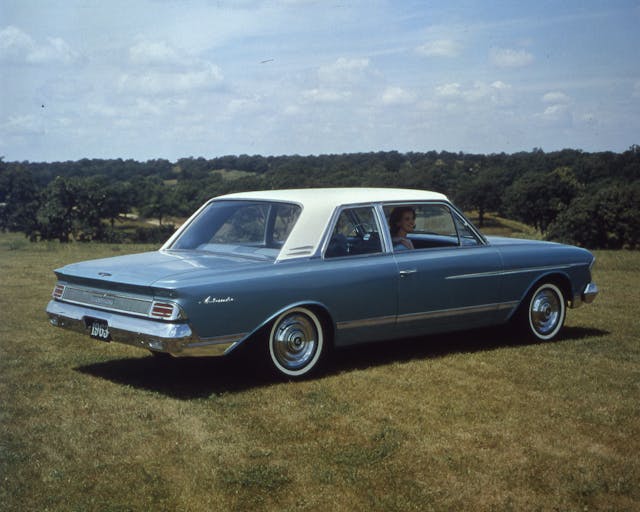
AMC’s full-size car was built in eight generations from 1958 to 1974 and could be had in a wide range of body styles, which often changed yearly, typical of its Big Three competition in that era. A rare sight at car shows, these big cruisers are bursting with style, as the Ambassador often served as the flagship model for AMC. In 1968, Ambassadors came equipped with standard air-conditioning while the feature was still optional across most of the industry, even on much more expensive models.
Our pick: While we love the funky, finned, ’50s four-door hardtop wagons, as well as the stylish two-door hardtops, we’ve got to go with the 1965–66 wagon. The interesting front-end treatment, with stacked headlights and horizontally mirrored grille, makes it look almost like a concept car. It was practically built for a Route 66 road trip. Besides, most of the rest of our picks are gonna be two-doors—we’ve got to be at least a little bit practical.
AMC Rambler American
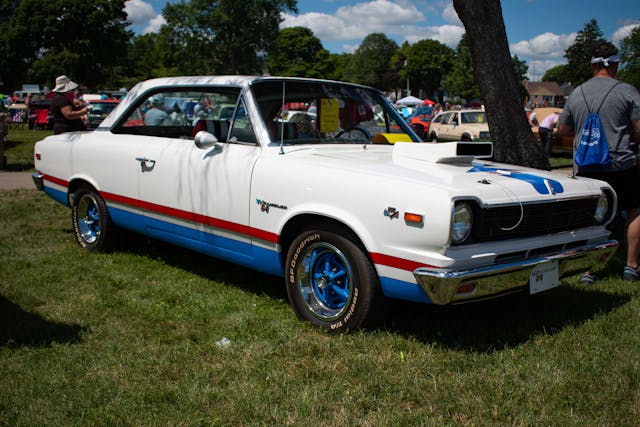
Built over three very different generations, the Rambler began as an elegant, sleek compact that stood out from the larger cars that were then dominating the market; it practically looked like a European import. The third generation introduced V-8 power to make a compact muscle car, the SC/Rambler, that would take on the sportier variants of the Dodge Dart, Ford Falcon, and Chevy Nova.
Our pick: The SC/Rambler with its red, white, and blue paint scheme is an easy choice, but we’ll go with some of AMC’s later models when it comes to patriotic color schemes. For our favorite Rambler, we’re gonna cheat a bit and pick an IKA Torino, which is what you get when Pininfarina gives this AMC a makeover. Built and sold by Industrias Kaiser Argentina and later Renault, the South American models were made famous thanks to their racing prowess. We’ll be honest, we wouldn’t care if they never took a checkered flag; we’re just interested in the looks.
AMC Rambler Marlin
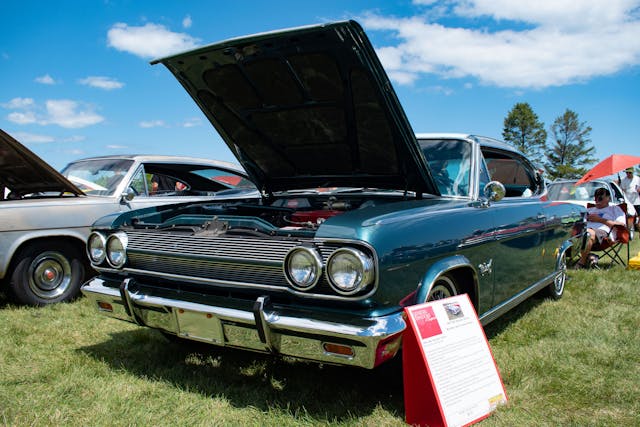
AMC’s midsize Rambler Classic spawned the fastback Rambler Marlin, whose sleek lines inspired Dodge to build the first-generation Charger. After just two years, Marlin moved to the larger Ambassador platform and kept the fastback design.
Our pick: We’re going to select the first-year Marlin, the 1965 model, which essentially serves as our favorite version of the Rambler Classic as well.
AMC Javelin
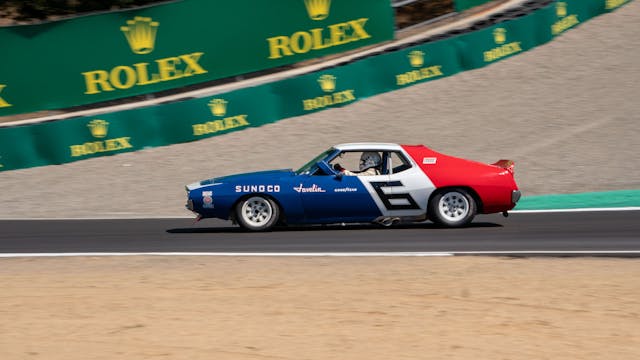
Whether it’s the rather understated early versions or the audacious, flared variants that came later, AMC’s take on the pony car is an attractive package. Like any good pony car, the Javelin was available with options to customize the style and performance, with several potent V-8 available. A blue, white, and red Javelin campaigned by Mark Donohue in 1971 brought the Trans Am championship to AMC for the first time, and in 1972, AMC nabbed driver George Follmer to repeat the performance.
Our pick: The one-year-only 1970 models featured a unique front end that is just different enough to notice from a distance. We’ll go with a 390 V-8 and a four-speed, in the red, white, and blue paint scheme that was the opposite orientation of the SCCA models.
AMC AMX
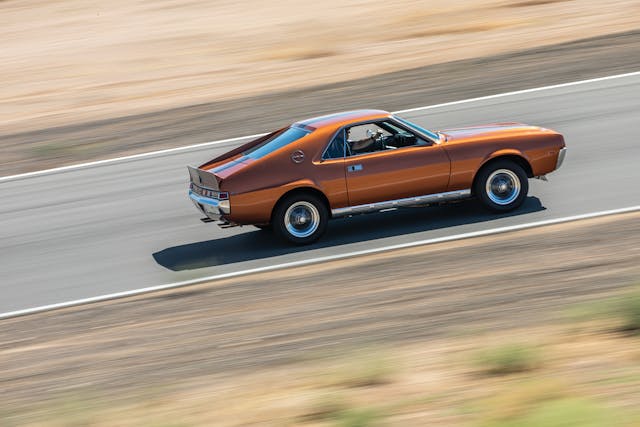
To create a two-door sports car and compete with Chevrolet’s Corvette, AMC shortened the Javelin and restyled it from the doors back. It’s a cost-cutting theme to which the company would return, but the AMX was arguably the best implementation of the strategy. AMC was proud to announce that the AMX started at less than $4000, the price of a loaded Mustang or Camaro. Production lasted from 1968 to 70, at which point “AMX” became an option package for the Javelin, then the Hornet, and eventually the Spirit.
Our pick: The AMX came standard with a V-8 and a four-speed with Hurst shifter, so pick your favorite AMC V-8, pick your favorite color, and go.
AMC Rebel

AMC’s mid-size follow-up, the Rambler Classic, filled a lot of roles as it was built in convertible, sedan, coupe, and wagon body styles. All of them look good, with interesting design cues like fenders and quarter panels with bulges to mimic the lines of their close-fitting bumpers, a design feature shared with the 1967–68 Ambassador.
Our pick: For style, it’s tough to beat the sleek looks of the 1967–69 hardtop, but we’ll still have to go with the 1970 Rebel Machine. It featured a 340-hp 390 V-8 that breathed through a sizable hood scoop and was available with a red, white, and blue paint scheme. It was loud, it was brash, and it was a solid performer thanks to a more powerful V-8 than even the AMX had. What’s not to love?
AMC Hornet
The compact Hornet sedan, successor to the Rambler American, was offered in two- and four-door variants when it debuted in 1970. A year later, it was joined by the Sportabout wagon, which AMC proudly claimed was “America’s only compact station wagon.” A sporty two-door hatchback joined the party in 1973. All of the body styles are rather attractive in their simplicity; perhaps that’s why we think they’ve aged so well. The muscular SC/360 version used a, you guessed it, 360 V-8 engine and was offered in muscle-car-appropriate colors and with a ram air induction system.
Our pick: While the most famous Hornet has to be the red hatchback from The Man With the Golden Gun (1974), the car that completed the miraculous corkscrew jump, we’ll take an earlier SC/360 model. How about a 1971 with the optional four-barrel, 285-hp engine with dual exhaust, four-speed manual, and 3.91:1 rear-axle ratio with Twin-Grip differential?
AMC Gremlin

AMC was used to being an underdog and doing a lot with a little. When it needed a more affordable, smaller car, it took the already compact Hornet, cut out 12 inches of wheelbase, and hacked off the rear to create the Gremlin. Sound familiar? Compared to the wonderfully proportioned AMX-GT concept that spawned the truncated subcompact, the Gremlin is a bit awkward. That doesn’t stop us from loving the odd little hatchback.
Our pick: Our initial thought was this wild, tracked Gremlin we spotted at SEMA in 2022, but how about something a bit more practical—a 1972 Gremlin X in Wild Plum? The 304 V-8 wasn’t a brutal powerhouse at the time, yet it was still punchy in the lightweight Gremlin. A modern tune-up with a decent cam and intake would make it a zippy runabout.
AMC Pacer
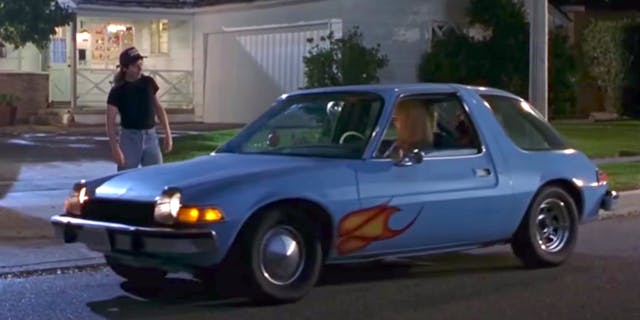
You can’t say that AMC was averse to taking risks. The Pacer offered unique, even strange styling with some practical benefits. The most oft-cited example is, of course, the passenger side door, which was longer than the driver’s to encourage rear-seat passengers to enter and exit on the curb side, where it was safer. The efficiently packaged interior offered fantastic visibility thanks to a greenhouse that used more window area. The car was also designed to be easy to repair.
Our pick: Our favorite Pacer has got to be the Mirthmobile, the only famous Pacer in existence. With a roof-mounted red rope licorice dispenser and a dash-mounted cup dispenser to go along with what appears to be an on-board water supply, it has tremendous road-trip potential.
AMC Eagle

These utilitarian sedans and wagons aren’t particularly eye-catching and would have blended in with plenty of their contemporaries if it weren’t for the fact that they rode a bit taller on their 4×4 suspensions. The drivetrain made them a precursor to the ubiquitous crossover and served to highlight AMC’s ambitious attempts to carve out new segments in the market. The Eagle sedans and wagons were based on the Concorde, the successor to the Hornet.
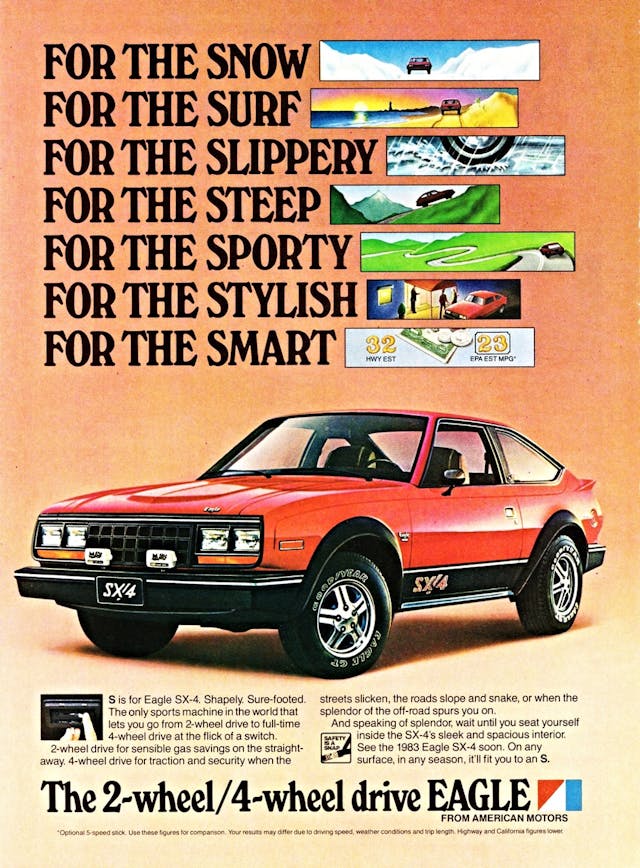
Our pick: The SX/4 three-door that was based on the smaller AMC Spirit is a rare sight today and would make for a fun rallycross-inspired toy.
Bonus:
XJ Jeep Cherokee

The XJ wasn’t branded as an AMC, but AMC was Jeep’s steward from 1970 to 1987 and the Cherokee was AMC’s largest contribution to the brand over that period, as most of the other models available were carryovers from Kaiser.
These boxy wagons weren’t the first compact SUV, although they set the stage for the future in several important ways. With lightweight unibody construction and a solid front axle with coil-spring suspension, the XJ Cherokee was maneuverable and capable off-road and had a decent ride on-road. Its quadra-link suspension made its way to the original Grand Cherokee in 1993 and TJ Wrangler in 1997. The Grand Cherokee was initially planned to replace the Cherokee, although strong sales kept the XJ in production until 2001 in the United States. Reskinned versions were on sale in China until 2014.
Our pick: A 1997–99 4.0-liter model to get the best of the upgrades that started in 1997 but the last of the high-pinion Dana 30 front axles.
This list had to be cut short, but we’ve managed to cover a pretty big swath of AMC’s lineup. Our favorites were biased toward the ’60s and ’70s, so let us know if we’ve overlooked your number-one AMC.
***
Check out the Hagerty Media homepage so you don’t miss a single story, or better yet, bookmark it. To get our best stories delivered right to your inbox, subscribe to our newsletters.


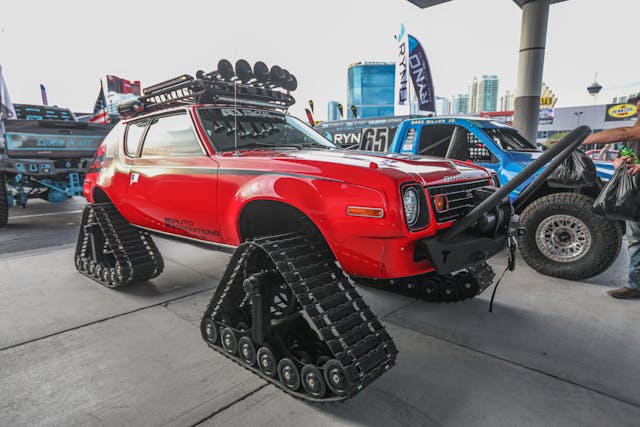








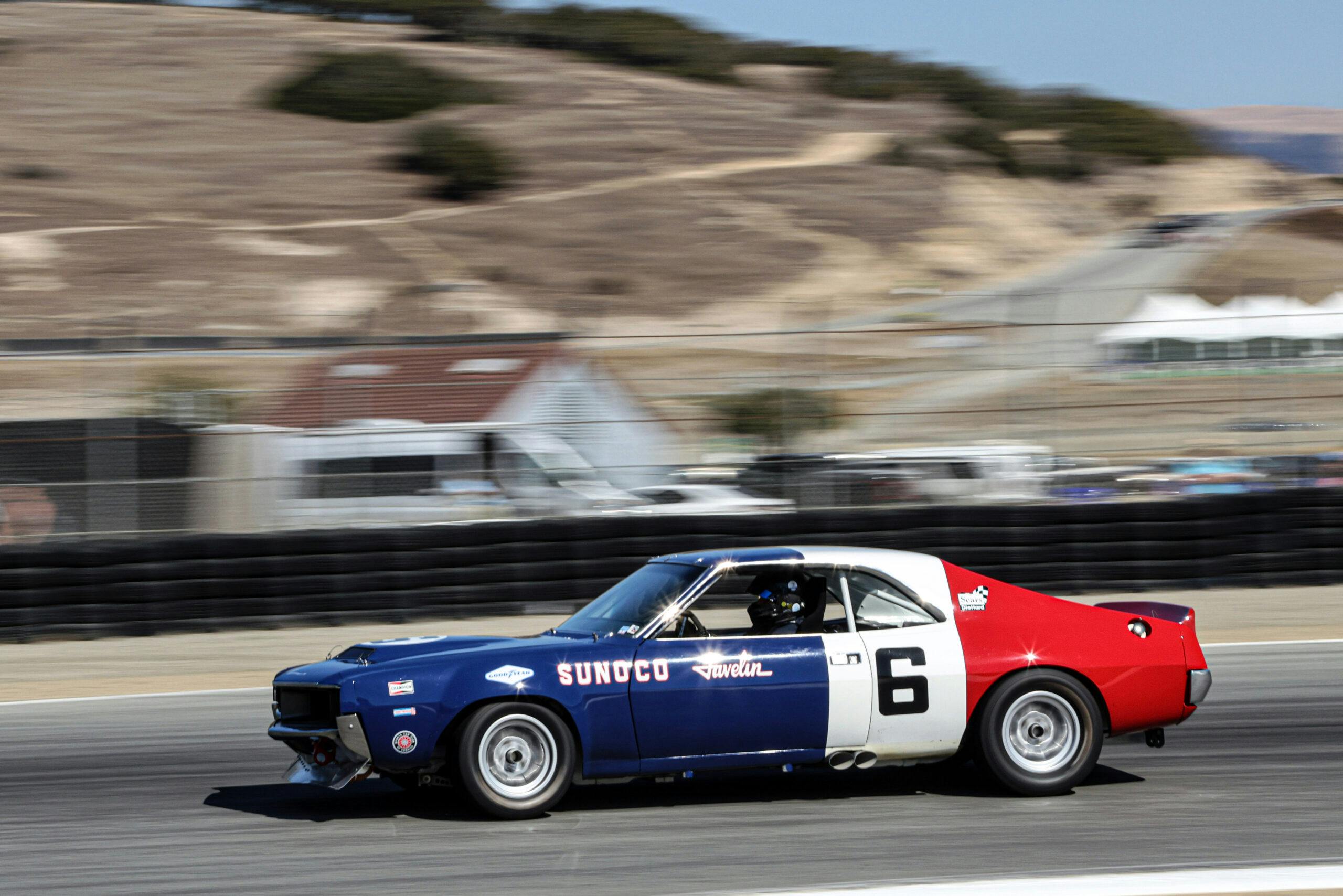
In the early ‘70’s my friend had a Rambler Scrambler. Very fast car. 360 ci 4bbl.
Javelin and AMX are my favorites here. The Eagle gets a special mention for what is was.
VAM made AMCs in Mexico that are styled somewhat differently than the US cars. My 68 AMX always turns heads, particularly among younger people who seem attracted to the smaller body.
My 2000 Cherokee is still running great.. 3rd one owned.. Dad had a AMC Hornet.. and drove Jeeps during WW II.. best vehicles ever!!! Bar none!! Company in Philippines makes WW II type Jeeps.. Body only.. you supply drive train!
My dad loved AMC, as did his family. He had a couple Gremlins, an X at one point, loved the Eagle, briefly had a Spirit, my aunt had a Pacer and the more station-wagony Hornet, my grandparents had a Gremlin and an Ambassador (I think my grandpa said it was an old FBI car, I was with him when the odometer flipped while doing laps in the parking lot so we could watch it, possibly not for the first time…). I’d guarantee at least one of them had a Rambler before I was born. Surprised my dad never had a Javelin or AMX, but I suppose it was my fault for him needing a back seat 😛 He loved the Cherokee of that era, but didn’t have a use for it amongst the 5 he had (he had rebuilt a Willys for his work car). He also had a Met too, for good measure as Nash kinda ended up AMC. 🙂
Growing up in the 60’s, embarrassing was my dad dropping me off in the 59 rambler wagon pink and maroon or whatever, good god!
Years ago I HATED AMC. Now, I’m so intrigued by them. Who knows…..I may own an AMC one day. I do have a 2001 Jeep Cherokee but…..it was built under the Chrysler era. One question I do have. Why did AMC remain with splined axles until the end?
Pacer !!!!!…..schwing !!!!
in 1983 I removed the front suspension from AMC Pacer, pretty simple, held in place with six bolts ,I narrowed it two inch’s and welded it to the frame of my street rod I was building, a really good front suspension with disc brakes and rack and pinion steering, almost forty years later still driving that car with the Pacer front suspension.
I think I recognize the Hornet display from the Buffalo Museum of Transportation/Pierce Arrow. The museum and the owners are worth an article on their amazing collections.
Agreed! That museum is amazing 🙂
1972 Javelin SST–built 360 hooked up to a 998 Chrysler torque flight tranny, and of all colors “Wild Plum Metallic. It left the factory with it so I had it repainted original.
In 1972 AMC only produced the– Javelin SST and the AMX–there was no just “JAVELINS” made, they were all labeled.
The designer of the 71-74 Javelin was I think it was Don Teague (I think)—he was influenced by what was going on around him—He used a little off of the Corvette fenders–the Mercury Cougar and Ford top—and Mopar “B’ bodies for the grill and front end — put them all together and came up what was called the “WET TEE SHIRT LOOK”. When I take my 72 to a show I get more people talking to me and taking pictures of my SST than any car there.—but seeing as how all the judges ride GMCs; Fords or Mopars I never get a trophy
It is who you know not what you show. And for some reason the ladies love the “Wild Plum Metallic “. paint.
We had an AMC Eagle wagon that was beyond tough. It was bad arse. My husband was rear-ended by a car going at speed. The young gal’s little Japanese car became much “shorter” and was totaled, while our Eagle’s rear bumper received just small scratches and maybe a very minor dent, the kind where you had to bend down and examine the area to see any damage at all! We sure liked that thing. It even looked “tough”!
Great article! Just an unexpected reminder of when cars had some personality and some originality. Doesn’t always have to be about “muscle”, just Detroit built innovation and fun…..and sheet metal. God, we miss those days. Long live the Rambler!
First thank you Hagerty for the tribute.
Roger Penske’s race team worked out of our AMC dealership shop when in town at the then Bryan’s motorsports park before going to the track in Loudon. So obviously, although I’ve had some of the mentioned, (3) 1970 javelin, 70 AMX, 71 javelin, 72 javelin, 73 javelin AMX, 74 javelin AMX, 70 Rebel Machine, 65 Marlin, and a lot of others not on the list.
Red white and blue 70 trans am Javelin is the favorite. I currently have a shell and all the body parts including ram air hood to make a tribute, hopefully it’ll be next after the 69 AMX that I need to restore.
And because I don’t let you get away with AMC mistakes, Concord, no “e”, not until Chrysler screwed everything up. And, there was a Concord AMX.
It must have been toward the end of Hornet production when AMC made a padded roof loaded version. When I was traveling I was given one as a rental. I thought “Oh well, a rental”. What a pleasant surprise compared to some of the other basic rentals I had driven back then. Smooth, quiet, solid with a nice ride without being mushy. Best of all it was one of the few rentals I drove that didn’t have something on it that didn’t work!!! After that my attitude towards AMC products improved.
I’d sure like to find a nice Eagle 4×4 wagon. It’s engine evolved into that great 4.0 litre Jeep engine so a replacement with more power is an easy fit. Towards the end the styling wasn’t good. Chrysler wanted the Jeep and bought AMC to get it, then dropped the rest. Then Chrysler got bought up by Stellantis for the truck division and uses their Euro platform for the new “Hornet”.